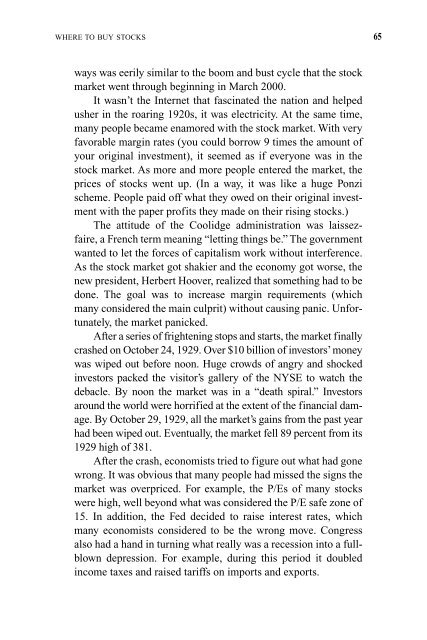Understanding Stocks
Understanding Stocks
Understanding Stocks
Create successful ePaper yourself
Turn your PDF publications into a flip-book with our unique Google optimized e-Paper software.
WHERE TO BUY STOCKS 65<br />
ways was eerily similar to the boom and bust cycle that the stock<br />
market went through beginning in March 2000.<br />
It wasn’t the Internet that fascinated the nation and helped<br />
usher in the roaring 1920s, it was electricity. At the same time,<br />
many people became enamored with the stock market. With very<br />
favorable margin rates (you could borrow 9 times the amount of<br />
your original investment), it seemed as if everyone was in the<br />
stock market. As more and more people entered the market, the<br />
prices of stocks went up. (In a way, it was like a huge Ponzi<br />
scheme. People paid off what they owed on their original investment<br />
with the paper profits they made on their rising stocks.)<br />
The attitude of the Coolidge administration was laissezfaire,<br />
a French term meaning “letting things be.” The government<br />
wanted to let the forces of capitalism work without interference.<br />
As the stock market got shakier and the economy got worse, the<br />
new president, Herbert Hoover, realized that something had to be<br />
done. The goal was to increase margin requirements (which<br />
many considered the main culprit) without causing panic. Unfortunately,<br />
the market panicked.<br />
After a series of frightening stops and starts, the market finally<br />
crashed on October 24, 1929. Over $10 billion of investors’money<br />
was wiped out before noon. Huge crowds of angry and shocked<br />
investors packed the visitor’s gallery of the NYSE to watch the<br />
debacle. By noon the market was in a “death spiral.” Investors<br />
around the world were horrified at the extent of the financial damage.<br />
By October 29, 1929, all the market’s gains from the past year<br />
had been wiped out. Eventually, the market fell 89 percent from its<br />
1929 high of 381.<br />
After the crash, economists tried to figure out what had gone<br />
wrong. It was obvious that many people had missed the signs the<br />
market was overpriced. For example, the P/Es of many stocks<br />
were high, well beyond what was considered the P/E safe zone of<br />
15. In addition, the Fed decided to raise interest rates, which<br />
many economists considered to be the wrong move. Congress<br />
also had a hand in turning what really was a recession into a fullblown<br />
depression. For example, during this period it doubled<br />
income taxes and raised tariffs on imports and exports.

















